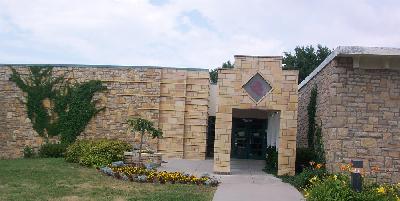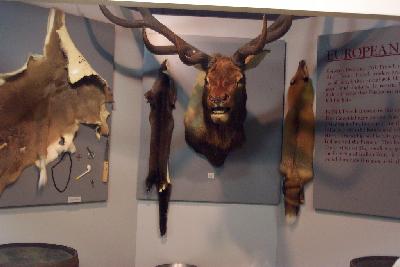
Wyandotte County Historical Society and Museum
631 North 126th St.
Bonner Springs, Kansas 66012
(913)721-1078
"This River receives its name from a nation which dwells at this time on its banks," Clark's Journal , 28 Thursday 1804

This is an excellent place to introduce students to the native peoples who were here when Lewis and Clark visited, and before. The well lit and informative museum galleries are laid out in an exceptional manner that will make it easy for a teacher with even a limited knowledge of the history of these early inhabitants of Wyandotte County to conduct a tour for their students.
The Kansa Indians were much on the minds of Lewis and Clark as they entered their territory. Lewis and Clark spoke mostly in negative terms about the Kansa Indians, whose members they never met. These displays give the students a view of the Kansa Indian's daily life that is not discussed in the Journals. Students should read these entries, and teachers should discuss them with their students before coming to the museum. A visit to the Kansa Nation web site will also help students understand these early inhabitants.
The museum is located in Wyandotte County Park, 3 miles west of I-435 on I-70. Take the Bonner Springs Exit or Highway 7 off I-70, and travel Highway 7 for about a mile north to 130th Street. Or, exit Highway 24 (State Avenue) off of I-435, and travel State Avenue West for 3 miles to 130th Street. There are plenty of picnic facilities in the park, or the area of 78th and State has several fast food restaurants. For the very adventurous, Cabela's Outfitters is located nearby at the Intersection of State Avenue and I-435 that contains an upscale restaurant.
It is only a few miles from Wyandotte County Lake located at 91st and Leavenworth Road. The Schlagle Library at that site will give students an understanding of the natural plants and creatures encountered by the expedition.
|
|
|
The museum has a collection of artifacts from the Trowbridge collection that documents the Hopewell, Native American people who lived here from approximately 1 Ad to 500 AD. A mural, informative displays and and a diorama illustrate their lifestyles. A knowledge that people inhabited and lived on this land for many centuries before the Europeans is necessary background for students studying the expedition.
|
|
 |
A canoe discovered on the banks of the Kaw River in the first part of this century gives the students a first hand look at a dugout not unlike those used by Lewis and Clark's Corps of Discovery. A display near by illustrates the riches of furs that drew the French to the area.
The museum also has a display of pottery made in the manner created by various peoples of different eras. It provides an excellent lesson for art teachers who are looking for an artistic link into the study of Lewis and Clark and the people they met.
Journal Entries Discussing the Kansa Indians
June 28, 1804
July 1, 1804
July 2, 1804
July 3, 1804
July 4, 1804
July 5, 1804